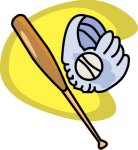Bill Buckner
|
|

William Joseph "Bill" Buckner (born December 14, 1949 in Vallejo, California) was a Major League Baseball player who, despite a respectable 20-year career, is best known for a ground ball that rolled between his legs in Game 6 of the 1986 World Series.
Career
Buckner played his first major league game in 1969 with the Los Angeles Dodgers (at the age of 19) and his last game in 1990 (at the age of 40) with the Boston Red Sox. He was an All-Star in 1981. He won the National League batting title in 1980 with the Chicago Cubs.
For his entire career, Buckner was known as one of the more consistent contact hitters in the major leagues: in 2,517 games, Buckner accumulated 2,715 hits and only 453 strikeouts. He four times led the league in most at bats per strike out (1980, 1982, 1985, 1986), and four times placed second in the category (1979, 1981, 1983, 1987). For his career he averaged 20.7 AB/K (compared to 18.5 for Joe DiMaggio, 10.9 for Ted Williams, 42.7 for Nellie Fox, 44.9 for Lloyd Waner and 46.3 for Tris Speaker).
Originally promoted to the majors as an outfielder, he moved to first base when he joined the Cubs. At that position, he played 1,555 regular season games and made only 128 errors in 13,901 chances, but he will always be remembered for one error he made in the World Series.
1986 World Series
On October 26, 1986, with the Boston Red Sox leading the New York Mets 3-2 in the best-of-7 series, the game was tied in the bottom of the tenth inning. Mookie Wilson of the Mets fouled off several pitches before hitting a ground ball to Buckner at first base. The ball took a deadening bounce on the dirt, rolled under Buckner's glove, through his legs and into right field, allowing Ray Knight to score the winning run from second base. It capped an astonishing comeback for the Mets, however, it did not (as is often misremembered) end the World Series. The Met victory, in fact, forced a seventh game, which was played two nights later and subsequently won by the Mets.
Some observers of the game believe that even if Buckner had cleanly fielded the ball, he still would have been unable to prevent Wilson from reaching first base. Wilson was a very fast runner, while Buckner had lost a large part of his mobility because of a long history of ankle injuries; it is possible that Wilson would have beaten Buckner to first base, which would have extended the inning.
Although many factors can be cited as to why the Red Sox lost the 1986 World Series, Buckner's error remains the popular focus of the blame. Moreover, the mistake was added to the lore of the Curse of the Bambino.
According to a popular Bostonian joke, the distraught Buckner threw himself in front of a locomotive in grief after his fielding error. The train passed between his legs.
Buckner has denied any lingering bitterness over the 1986 Series fiasco, pointing out that was a key member of the team that year. He hit 8 home runs that September, with 22 RBIs and a .340 average, missing only three games. He drove in over 100 runs for the season.
Buckner's willingness to play injured may have contributed to his famous 1986 World Series error.
After Buckner retired from professional baseball he moved his family to Boise, Idaho, where he invested in real estate: one of the housing subdivisions which he developed is named Fenway Park.
The "Buckner Ball" was later auctioned for $93,000. The high bidder was Charlie Sheen. The ball is now in the collection of Seth Swirsky, who refers to it as the "Mookie Ball."
Buckner also played a supporting role in another of baseball's milestones, as the Los Angeles Dodgers left fielder seen climbing the fence in an attempt to catch Hank Aaron's 715th Home Run on April 8th, 1974.
Baseball Clipart
- Baseball Clipart (http://classroomclipart.com/cgi-bin/kids/imageFolio.cgi?direct=Clipart/Sports/Baseball_Clipart)
